
The first Michigan Interdisciplinary Mathematics
Meeting on the topic Modeling and Analysis in Medicine and Biology
was held in the Mathematics Department of the University of Michigan,
at the beginning of August. There was an excellent lineup of speakers,
all of whom gave wonderful talks, there was a conference banquet
at the Michigan League, and a number of posters rounded out the
meeting.

Day 1. We heard first
from Charles Peskin, who showed impressive videos of his latest
computational results on blood flow in the heart, and then from
Sally Blower, who described her work on the emergence of antiviral
drug resistance. In the afternoon, George Oster gave us a wonderful
tour of various complicated bits and pieces inside cells that
build ATP, and finally Bard Ermentrout, in an impressive display
of restraint and gentility, educated us on the properties of waves
in synaptically coupled neuronal populations.
Day 2. First Lee Segel
talked about the role of feedback, particularly spatially localised
feedback, in the control of the immune system, and then our very
own Jennifer Linderman (from the University of Michigan that is)
discussed ligand efficacy, and showed us, among other things,
that drug companies don't always do the right thing in their search
for new drugs. Neither do rock stars I suspect. James Keener,
almost defibrillating in front of our very eyes, gave an excited
and exciting demonstration of the powers of homogenization, and
the usefulness of arms as models of channel gates. This was when
he wasn't trying to advertise his new book. I hear this book is
very good and you should all go out and buy at least one copy.
(See more details in this newsletter.) Finally, John Tyson, in
typical calm and collected fashion, led us through some of the
intricacies of the cell division cycle.
Day 3. We began with De
Witt Sumners, who showed us that knot all topology is pure as
the driven snow, but can actually (horrors) be useful. Very broadening
to the mind. Simon Tavare talked about stochastic models and their
use in the study of evolution and hereditary diseases. Finally
Robert Eisenberg applied the Eisenberg certainty principle (as
first proposed by B. Ermentrout of course) to models of ionic
channel flow, and Suzanne Lenhart discussed how the principles
of optimal control can be applied to the study of population models.
Her talk of killing beavers caused some disturbance, but she reassured
us that she does not do the dirty deed in person.
Overall, an excellent conference (I have to say this, as I helped to organise it), and we (Charlie Doering, Denise Kirschner, Kenneth Lange, and myself) thank all those who participated. Future MIMMs will be held each year, but they won't be on Mathematical Biology, and I won't be organising them. This is a good thing.